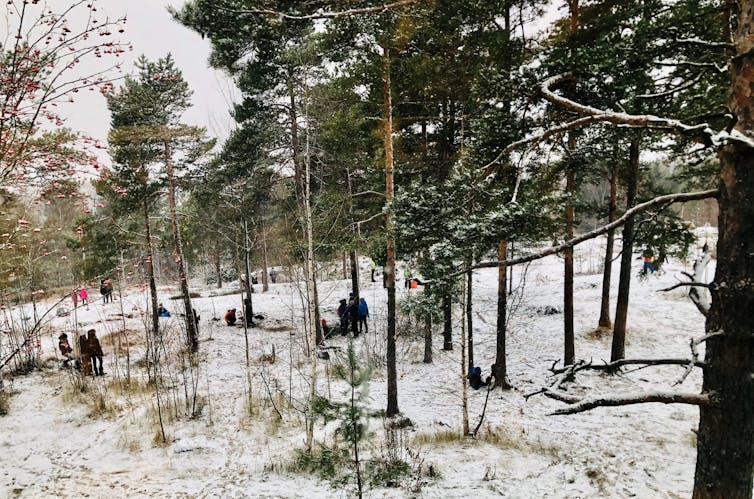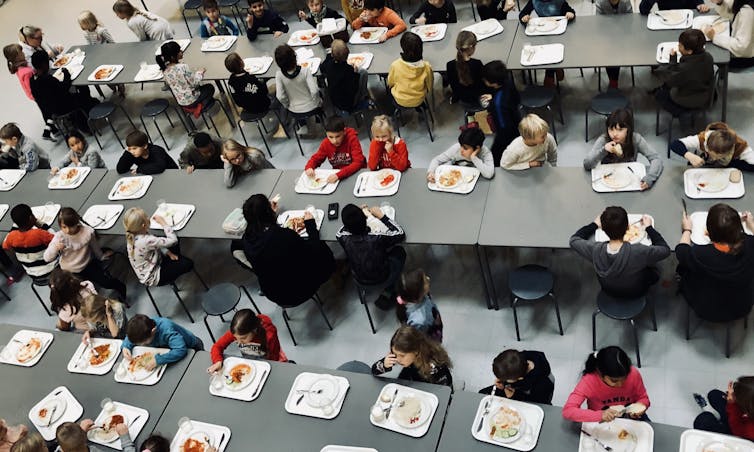
Theodore Christou, Queen’s University, Ontario
All four teacher unions in Ontario are in the midst of labour unrest.
Teachers in Ontario have long had the right to strike, and when the province threatened this right in 2012, the courts upheld it.
While the list of particular negotiating points between the government and the four unions depends on the situation, there are common priorities: funding, class sizes, job security and salary.
When we examine the past 20 years of education strife in Ontario, it’s clear that labour unrest has become a response to a wider failure to adequately invest both financially and imaginatively in schooling.
Read more:
Mike Harris’s ‘common sense’ attack on Ontario schools is back — and so are teachers’ strikes
Playing politics with schools is not an anomaly, it has become the norm. It is exhausting, particularly for the province’s public educators, parents and students.
Perhaps it’s time for Ontario residents to look elsewhere. We have had to imagine and invent the kinds of schools we wanted in the past. We can always re-imagine them.
What about Finland? What can we learn from a place where the government is led by Sanna Marin, a 34-year-old woman with new ideas about old institutions?
Recently, I was welcomed into Helsinki schools to observe and learn about what the Finns call “phenomenon-based learning” — a philosophy that supports their schooling.
Finland has been on the radar of international educators for nearly a decade for various reasons, including high rankings in the international game of right answers (also known as the Program for International Student Assessment or PISA) and a well-defined international marketing plan for Finnish educational ideas. The world is increasingly aware of the pride Finnish people have in education.
Finland is one of the top global investors in education, spending a larger fraction of its GDP on education than Canada.

The Roihuvuori Comprehensive School, Lower Stage (grades 1-6), in Helsinki, Finland, is in a large building with skylights that houses a wood and metal shop. (Theodore Christou), Author provided
Phenomenon-based learning
Phenomenon-based learning is a distinctly Finnish approach to inquiry learning in schools. It means leading students to ask big questions that don’t have easy answers.
Labour action, as an example, could be a phenomenon that would keep most students engaged for many months.
It’s also a brand, because it’s marketed as a distinctly Finnish approach rooted in the Finnish context.
Books on phenomenon-based learning can be found in tourist shops and on display during Helsinki Education Week, and programs have been promoted as part of Finland’s educational reforms. This branding is intentional and explicit, which is refreshing in the marketplace of ideas in which we live.
Ontario, too, has inquiry linked into its curricula, notably in social studies and history. Ontario’s students are familiar with science projects or social studies units, but in Finland, inquiry is all encompassing. It requires students to step outside of subjects to ask broader questions that aren’t limited to what needs to be covered in the curriculum.
Chopping wood at school
On my trip, during a visit to a third-grade classroom, all the students were engaged with a particular phenomenon: How would we respond to a loss of electricity?
Children were chopping wood, deciding how to divide resources and making paper airplanes.
Where would such an approach come from? Academics like me are trained to look for the ways that research affects practice in education.
The ideas of John Dewey have influenced Finnish education, as outlined by Finnish educator and researcher Pasi Sahlberg. Dewey was an influential 20th century American philosopher who is often associated with democratic living and engagement in meaningful activities in schools.
Read more:
Finnish education guru Pasi Sahlberg In Conversation: full transcript
Sahlberg writes that “Dewey’s philosophy of education forms a foundation for academic, research-based teacher education in Finland.”

Children explore the first day of snow outside their school building on wooded lands at the Roihuvuori Comprehensive School, Helsinki, Finland. (Theodore Christou), Author provided
In the class I was visiting, I was curious to know what or how the teacher thought about Dewey. But the notion that he had impacted Finnish education didn’t resonate for her and she said phenomenon learning is a Finnish idea.
Her response suggests that whatever aspect Dewey contributed has indeed become a Finnish approach in its own right.
Education more than schooling
I asked a group of three girls in an upper secondary classroom (roughly, Grade 11) if they felt educated.
“We know that our schools are impressive. You came all the way from Canada to talk to us about our learning. But you did not come across the world to talk about small things, right?”
She was correct. I was interested in getting outside of my own context to see what was possible. I was a host in a class focused on entrepreneurship, where the students’ phenomena were start-up businesses that integrated their learning and applied it to the real world of commerce.
“Yes, we feel educated. Sometimes we learn in the school. Doing phenomena like this. We also have classes in history and mathematics. But we also learn during our breaks, talking to each other. School plays a role in our education, but it is not only school that educates us.”

Children at the Roihuvuori Comprehensive School, Helsinki, Finland, eat a warm lunch provided at school every day. The entire school staff may also eat with the children.
Finnish schools are also affected by labour action. Recently, 20,000 children had to eat cold meals as service sector strikes made it difficult for them to have their warm meals served as per custom in early childhood settings.
Schooling and education
Why should Canadians pay attention to education elsewhere? Even in our own provinces, it is a challenge to understand the intricacies of schooling elsewhere across the country.
Schools are not fixed, nor are their structures. We have made them up and we can change them. And we should not confuse schooling with education.
Travel, through books or via other means, enriches our view of the world and our place within it.
Everyone with something at stake in Ontario’s schools ought to ask: “What is an education for, anyway?” The questions we ask colour the way we look at our own schools and our educational investments.![]()
Theodore Christou, Professor, Social Studies and History Education, Queen’s University, Ontario
This article is republished from The Conversation under a Creative Commons license. Read the original article.




13 Comments
Pingback: Why Finland is the happiest country in the world for the past six years - Bergensia
Pingback: เว็บบอลจ่ายจริง กับบอล euro 2024
Pingback: เว็บมวยราคาดีที่สุด
Pingback: url
Pingback: website bovenaan in Google
Pingback: Bilskrot Lamborghini
Pingback: นาฬิกาก๊อป
Pingback: pk789
Pingback: som777
Pingback: marbo 9k
Pingback: มาชัวร์เบท เว็บแทงหวยครบวงจร
Pingback: รับจัดงานอีเว้นท์
Pingback: เว็บตรงสล็อต